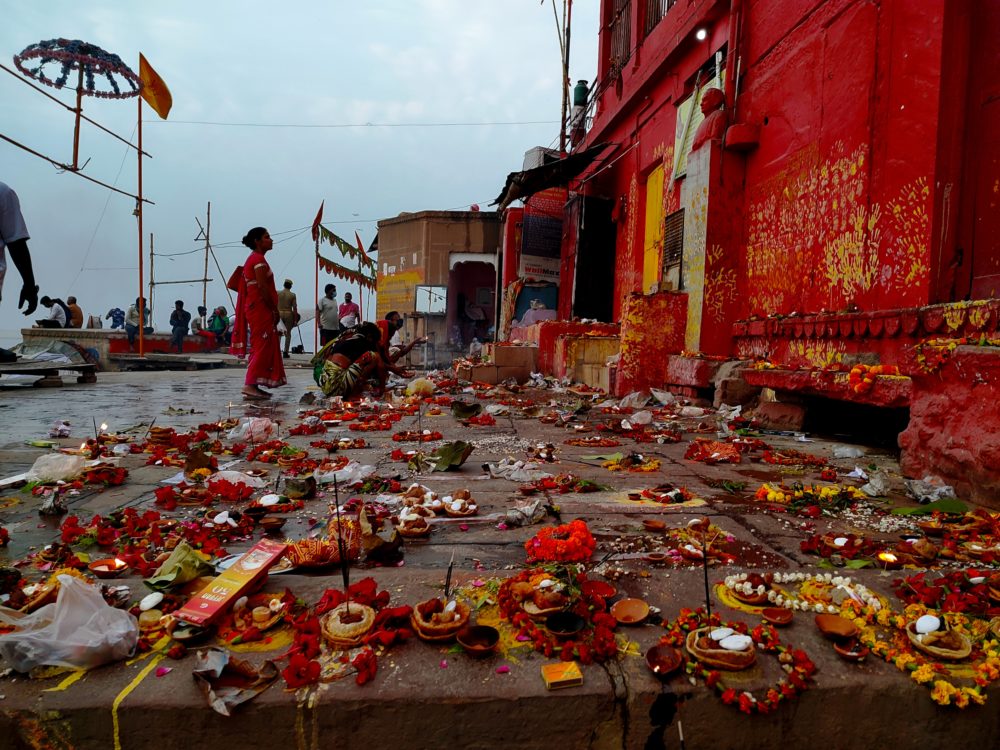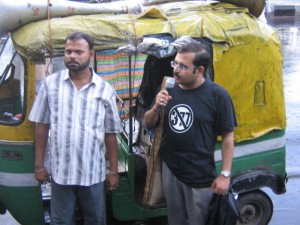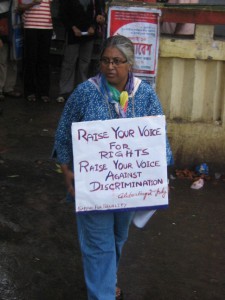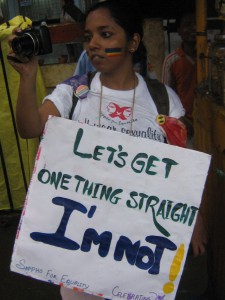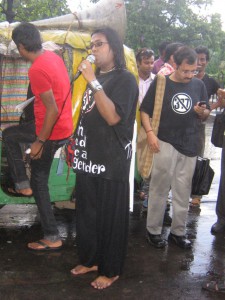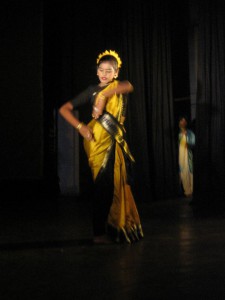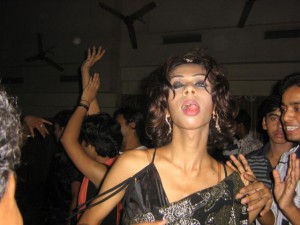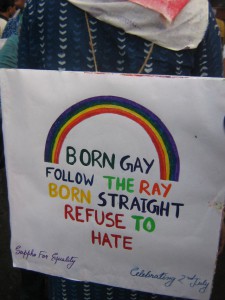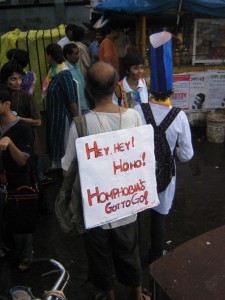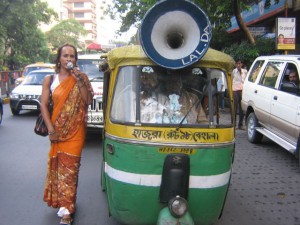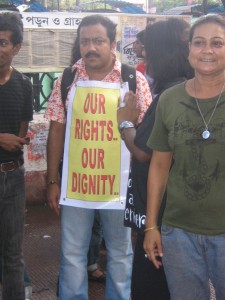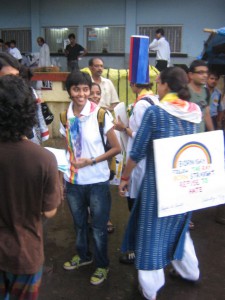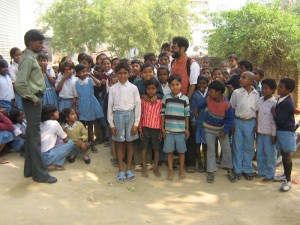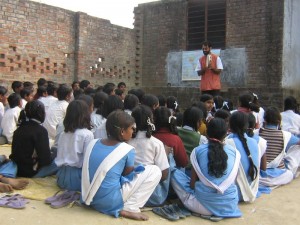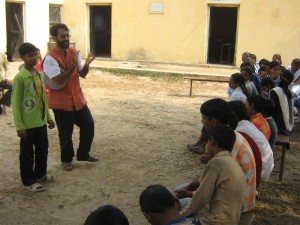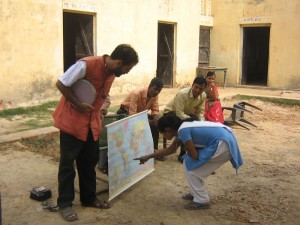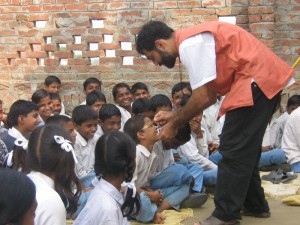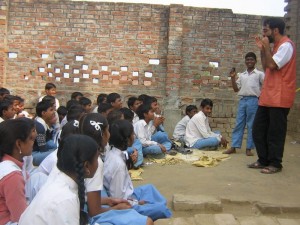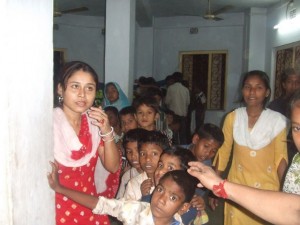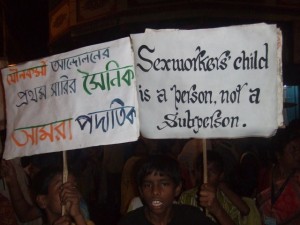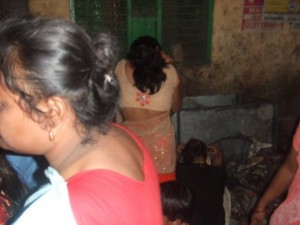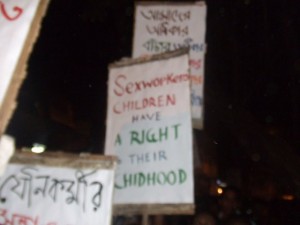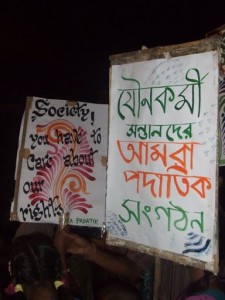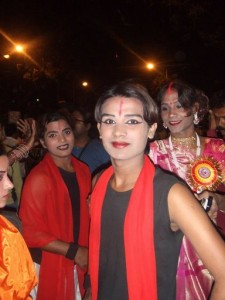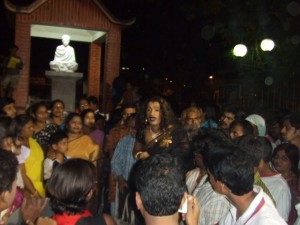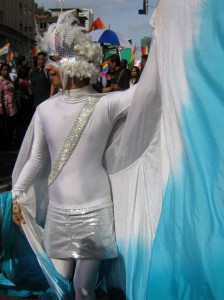
I loved his costume
I attended Mumbai gay pride on the 16th of August. It is celebrated on this particular date because the gay community organizing this event says that India got freedom on the 15th of August but gay community never got� freedom so they decided to celebrate their freedom one day after the independence day of India. The event was basically organized by an NGO called Humsafar that works with the gay community in Mumbai. I had already contacted people at Humsafar about my project and they were very welcoming. I was in Gwalior doing my training but I took a leave of 4 days and flew to Mumbai. I arrived in Mumbai on the night of the 14th.

They were at Delhi pride also
I had attended this year’s Delhi Pride on the 26th of June and I really missed a video camera but I had arranged a video camera to record Mumbai Gay Pride. I had asked my friend Yogesh, who works in Bollywood, to arrange a camera for me and he provided me everything I wanted. I went to Humsafar on the 16th with a camera person and a friend from the US named Ryan. We met in Benares and I invited him to attend Mumbai Pride with me. I wanted to cover the preparation for the parade, interview a few people at Humsafar, interview a few people at the parade,� participate in it, enjoy the party and make some new contacts to work together in the future.
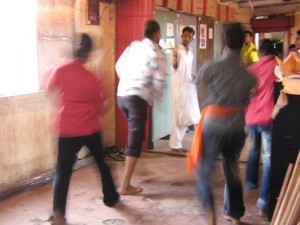
Preparation for the parade
I was supposed to start interviews at Humsafar at 12 o’clock but when I reached there I found that there were already a few media people interviewing Humsafar guys but they arranged a guy to show me their office. The office was amazing; they had an HIV and AIDS testing center. I had already been to a few NGOs but I had never seen any NGO having an HIV and AIDS testing center before, so it was really impressive. The Humsafar guy took me to the second floor of the office where they were preparing for the next day’s parade. There were about 20 guys practicing dance. A few of them hijras also. They had a guy to play Punjabi dhol and a big music system. I was surprised to see that they were practicing some traditional dance of hijra culture.

A poster at Humsafar office
I just spent sometime watching the people preparing for the parade; they were really working hard and seemed so excited for the parade. All of the performers were either homosexuals or hijras who come to Humsafar if they need any help. The guy showing us the office told me that the CEO of Humsafar, Mr. Vivek Raj Anand, had just arrived at office and he asked me if I would like to interview him and I really felt lucky that I got to interview him. He was really amazing, very well educated, had very good knowledge of the issue and he really knew what he was talking about. He did not have much time but I got 15 minutes and I think it was good enough to start.
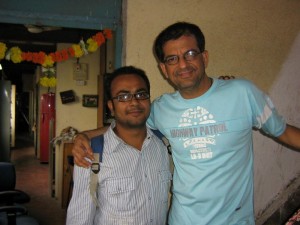
Mr. Vivek Raj Anand, The CEO of Humsafar and I
I believe that the gay community has always been in existence in India but a lot of people see it as a disease which came from the West so whenever I interview someone about gay culture, I always ask them about the history of gay culture in India. I ask them to tell me about the presence of gay culture in Hindu religious books because I know that Indians do not want to compromise with the religion and once they know something is part of their religion and culture, they are always so welcoming to this idea. And I also wanted to do the same thing, because I believe that if people know that gay culture has always been part of our culture, the it would be easy to make them understand the issue.

A participant of the parade
My idea behind interviewing all these people was to interview them and put the interviews online. I had intentionally done the interviews in Hindi so that people living in India could understand them. The interviewee told me a few stories that came from Ramayana and other Hindu religious books which showed the presence of gay culture even during Ram’s time. He talked about what kind of problems he had to face in society, how people discriminated against him, how he came out of it and what is the hope for the future. It was really interesting to learn the history of gay culture in India. He had very good knowledge about history of gay culture in India, especially in Hinduism.
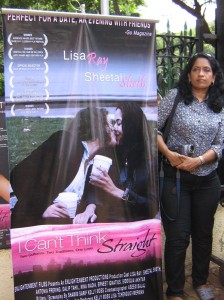
Posters at the parade
Mr. Anand asked me to work with the MSM community in Benares. He said that he could give me a project or he could get me one through the UP government which was something I really wanted to do. We talked about working together in Benares but he said that Humsafar doesn’t work out of Mumbai and Thane district. He said that he would help me with anything I wanted- funding, training or any other thing but they will not go out of Mumbai and Thane district officially to work. I think I will not be able to work with him soon as my NGO is not registered under section 12 A and any NGO can not get this registration until they are at least 1 year old. But now Sanjeevani Booti has completed its 1 year and now I can apply for this registration.
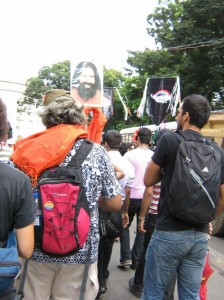
Thank you Baba Ramdev
Mr. Anand told me during his interview that he wants to thank Baba Ramdev on behalf of the whole gay community because Baba is the one who challenged the judgment of the high court of Delhi in the Supereme Court of India to revoke of section 377. He said that the Supereme Court of India would also give the judgment in favor of the gay community and this way they would have equal rights very soon. He said that there was no one who bothered coming against the judgment of Delhi high court but it was Ramdev Baba who brought this matter to the the Supereme Court of India so thanks to him. I would also like to thank Baba Ramdev for making the process faster.
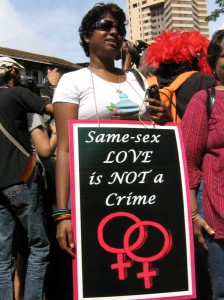
Absolutely not
I interviewed the Mr. Anand, the manager of Humsafar, one bisexual , two hijras, and few gays. It was really a nice experience interviewing them and listening to them and their stories. All of them were a little different from each other but they had the same issues. I think everybody whom I interviewed at Humsafar talked about discrimination the most. The manager of Humsafar told me that he wanted to get his passport with his gender showing either a girl or a hijra or a transgender but the government officials do not want to do it. Government officials tell him that they just do not know what a transgender is.
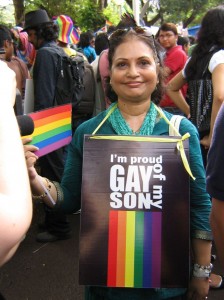
She was really interesting
He said that he has gotten his name changed officially to a female’s name and now preparing for a gender change operation but still the government doesn’t want to issue him a passport showing his gender as a female or as a hijra or as a transgender. He has sued the government for this reason. He was saying that gender change operation facility is not very good in India and he wants to go abroad to get it done but since the government is not issuing his passport he is unable to do it. He said that he has decided that he will take his passport only if they issue the passport with his gender showing as a female or a hijra or a transgender.

The hijras I interviewed and I
He told me that he only looks like a man from his body but he is not a man, he is a woman. I interviewed one Muslim guy also who was with a group of two hijras. This interview was also very interesting. It was the first time when I interviewed any Muslim gay. He said that his family will never allow him to get married with a man, which is what he wanted, so he has decided to either escape from the home or just stay unmarried for his whole life. The hijras were also fantastic. They told me a lot of things about hijras that I did not know before.
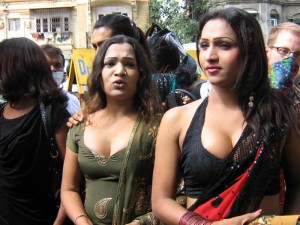
Biggest attraction of the parade, for me:)
I never understood the difference between people’s use of the word “hijra” and a “gay” and when I asked him about it they said that educated people use the word gay and uneducated use the word hijra, that’s all. They also talked about the issues hijra community is facing in India and it was exactly as the issues of other people whom I had interviewed at Humsafar. Hijras told me something really interesting that there are two different kinds of hijras.
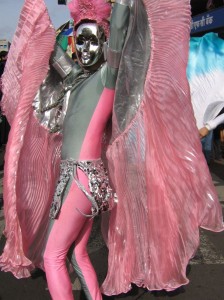
look at the costume, awesome
One of them is more respected in amongst hijras. They get married to the hijra goddess when they are so young. They have to wear a thread all the time which represents their marriage with their goddess. They can live with their family as well which doesn’t happen with the other kind of hijras. The hijras who bless and dance� at the weddings are different than them; it was really interesting, and I need to do some research about it. I interviewed a bisexual who was in fact a male sex worker. It was the first time when I had ever met any male sex worker and it was amazing talking to him. He also had few issues likes discrimination because he was a bisexual guy.
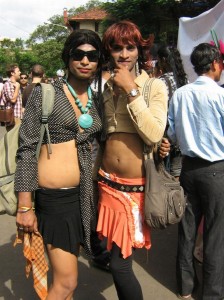
Participants at the parade
He said that when he was 14 years old and would go out with his friends and his friends used to look at the girls but he never felt like he had any interest in girls. He said that when he turned a bit older, he met Mr. Anand who brought him to Humsafar and that was the time when he came to know why he did not have any interest in girls. He joined Humsafar and now he works there as a program manager. He said that he used to distribute condoms to the male sex workers at railway stations and once he gave a pack of condoms to a policeman thinking that this policeman was a male sex worker. The policeman slapped him and kicked him out of the railway station; it was a funny story.
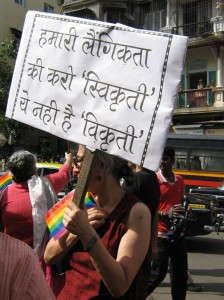
Aceept our sexuality, it is not a defect
The first day was all about watching people preparing for the event and interviewing a few people at Humsafar. After completing the interviews on the first day, we came out of the Humsafar office and we were standing on the road waiting for an auto-rickshaw and at the same time a 25-26 year old guy named Sourendra came to me and started talking about what we were doing in Humsafar office. I had already seen him in the office so I also didn’t hesitate telling him about my project. He asked me where I was from, what I was doing at Humsafar etc. and then he asked me about my project and said that he was also gay and visits Humsafar on regular basis.

Folk dance performers at the parade
He seemed to be an educated and interesting guy. He asked me where I was going and after my answer he said that he was also going to the same direction. He said that he also wanted to come with me. I asked him if he would like to be interviewed and he said- why not. We went together to my friend’s place and my friend drove us to somewhere where there was a litti-chokha (very famous Bihari food) party. We all went together and I interviewed him over the dinner at 1 o’clock night time.

377 out
Actually I regretted that I took him to that party because the guys over there at the party got too much interested in him after hearing that he was a gay. They would all come, look at him and laugh. I was really not comfortable there and I told my friend to change the place but since it was already 1 o’clock night time, we just decided to continue the interview at same party place. Sourendra was such an open and energetic and nice person. He talked about a lot of things that usually people do not want to talk about.
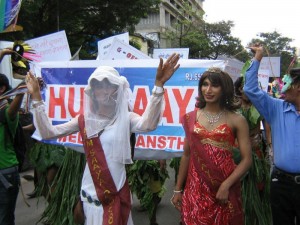
Participants at the parade
He talked about his sex practices and this conversation was really interesting.� He talked about discrimination in the society, family, friends and discrimination at his job. He used to work at a call center and everything was fine for him. After a few months the call center in-charge changed and a new guy came who seemed like did not like gays. Sourendra’s voice was was sweet, like a girl, but this new in-charge wanted him to speak with a heavy voice which was something unnatural for him. He said that he pretended to speak with a heavy voice but it did not work and his performance level decreased and finally he had to leave the job only because he could not speak with a heavy voice.
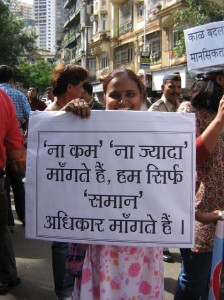
Neither less nor more, we just ask for equal rights
When I asked him about the existence of gays and hijras in our religion and history, he told me something really interesting. He told me about the existence of gays and hijras during Krishna’s time. He said that once Krishna also wanted to sleep with a man. It was something that I had never ever heard before. I know that Ramayana in North India is different than Ramayana in South India. They have some difference between them like Ramayana in North India says that Hanuman was a celebate and South Indian Ramayan says that Hauman had more than one wife. People living in the North do not eat fish because it is meat for them and people living in West Bengal eat fish because it is sea food for them.
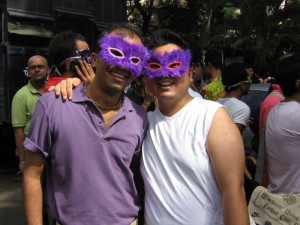
Bijay with his friend
Different people have different beliefs about the same thing and maybe the case here was also the same: the Mahabharta Sourendra had read was a little bit different from the one I have read, not an issue at all. I liked interviewing Sourendra. After completing the interview we dropped Sourendra at the railway station. I was so excited for the next day’s parade. I was supposed to meet my friend Bijay, who lives in Chennai, at the parade. He was also gay and was in Mumbai to attend the parade.
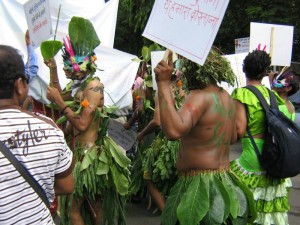
Aadimanav
We met at the Church Gate and headed together to the parade. I had two other guys to help me with the camera and other things. Mumbai Gay Pride seemed different than Delhi Gay Pride. I think the organizers had tried to give a cultural look to the parade. There were folk dance and song performers from South India and they were performing local dance of South India. I met Laxmi also at the parade.� The parade was a little bit delayed as other things in India and started around 12 o’clock. I think the number of people at Delhi Gay Pride and the Mumbai one was same, something around 3000 people.

Youngest participant of the parade
A group of people was carrying a huge rainbow flag. Mumbai seemed more respectful to the flag than Delhi. People at the Delhi parade were so excited that they started jumping with the flag and tore it off only few minutes after the parade had� started. I saw a guy with his four or five year old daughter at the parade. She was sitting on her father’s shoulders and was holding the flag. A few of my foreign friends tell me that although they support gay rights they do not like gay pride parades as they are so vulgar but in India situation was the completely different- very cultural, good enough even for a five year old girl.
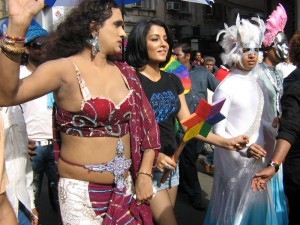
Laxmi and Celina
People were dancing, jumping and laughing so it seemed like a very happy event. I was also enjoying it. An hour after the parade started, a Bollywood actress named Celina Jaitely joined the parade. She has been involved with gay rights issue for a long time in India. I saw many Bollywood and TV stars at the parade. I think she was in the parade for more than an hour. There were a few guys with Celina and they had dressed amazingly. I had never ever seen anything like that before. Laxmi, Celina and everyone else at the parade were dancing and enjoying themselves.

look at the masks
I saw two Muslim girls also at the parade who were wearing Burka. They joined the parade an hour before its end but they also seemed to be enjoying it. They were also dancing with other people but most of the time they wanted to be under the gay pride flag. I think they were concerned about their identity. Many people seemed concerned about their identity like at Delhi Pride. They had covered their faces with clothes or some kind of masks. I just don’t understand why people come to the gay parade if they are so concerned about their identity? Better stay at home and watch it on TV if they can not support it openly.
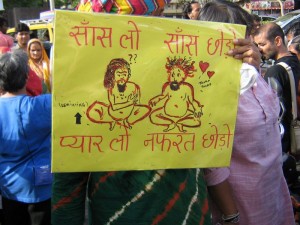
Baba Ramdev would like it
Mumbai Gay Pride seemed more organized in some ways. They had a van stuffed with banners, posters, masks, t-shirts etc. But masks and t-shirts were the most demanded items. I also tried to get one t-shirt but could not because they ran out within few minutes. They were distributing bottled water also to the participants. They had few volunteers with big bags who were collecting all the garbage, poly bags and bottles used during the parade. They said that they did not want to leave anything as garbage on the road, so this was a very clean festival which usually doesn’t happen in India.
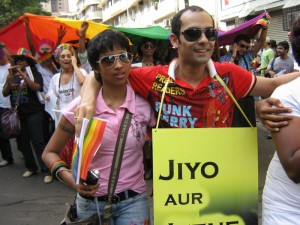
live and let live
I saw many people looking through their balconies and windows of their houses. I am sure they were surprised. Many people just joined the parade serendipitously. I saw a few people who were standing somewhere along the road doing their business, and then they saw the parade and joined it. One thing was very sure that Mumbai pride had more transgenders and hijras than at Delhi parade. There was a group of hijras which was right behind the flag performing some traditional hijra dance but this dance was not something I had seen hijras doing where I live. This hijra dance seemed more organized and calm, but usually hijra dance is very energetic and loud.

Meeting after the parade
The parade was moving and moving and I was just filming the parade, talking with participants and enjoying it. Finally the parade stopped at August Kranti Marg sometime around 4 o’clock where a few social workers and NGO members delivered a speech about gay rights and their future planning. I also took a break and went to the beach nearby. I did some filming there also and interviewed a gay couple whom I had seen at the parade. One other thing that was in my mind was the� repeal of Section 377 and I wanted to talk about it with the participants of the parade and members of Humsafar.
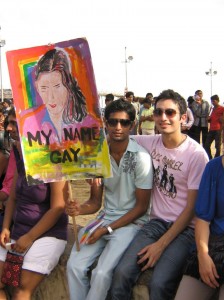
They were so happy
I asked about repeal of Section 377 to almost everyone I talked with and everybody was so happy about it. There was a guy who told me that these kind of laws are very important for bringing change in the society. Section 377 did not affect gay culture very much in India, even when it was effected, because you never know who is doing what inside their room but the worst thing that happened because of implementation of 377 was that it changed the thinking of people over time. But now since 377 is repealed, it will take some time, maybe 50 or 100 years, but someday gays will have equal rights in India. I also believed what he said.
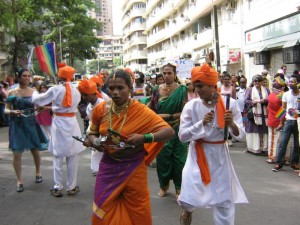
Hijras
After the parade ended, my friend Bijay took me to a very famous and old restaurant near August Kranti Marg. After having a few bottles of beer, we headed to Bijay’s hotel. I spent some time at Bijay’s hotel and then we headed to the party place. The party was organized at a disco but the Mumbai party was different from Delhi one. The Delhi party was organized by the organizers of the parade whereas the Mumbai party was organized by the participants. Delhi party’s entry was free but Mumbai party’s entry was Rs. 500 but they gave me three free drinks.

my friends and I after the party
The Mumbai party had more people than the Delhi one and it had more lesbian couples also. It was my second time at any disco after the Delhi pride party and I was so excited for it. I don’t know why but I drank a lot of beer that night at party and got completely drunk. I saw many gay couples kissing and hugging each other which was not new to me but my friends were so surprised to see it the way I was surprised at the Delhi party. The party was supposed to last for the whole night but I had to leave early as my flight back to Bhopal was at 6 o’clock morning time.
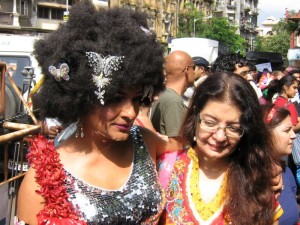
look at the costume
Ryan helped me by packing up my stuff and bringing me to the airport. Somehow I arrived safely in Gwalior but that I will not forget that party night, it was crazy, I loved it. This trip was very successful because I got to meet with a lot of new people, interviewed them, learnt a lot and built some business relationship with Humsafar. They have invited me again to the parade next year and I will try to attend it. I still think about the people I talked with, their issues, their stories… it was so nice talking with them.They are fighting for a issue which should just not be an issue.
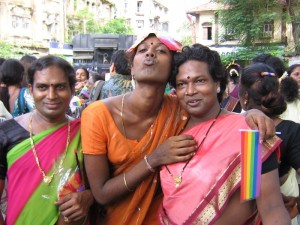
very happy picture
My friend Sanjay, who helped me with camera, told me what I was doing was crazy when I explained him my reason for being in Mumbai but after listening to the people I interviewed, his mind also changed. He also told me that gays should also have equal rights in our society. Actually my question stories of gay culture in Hindu religion worked for him. All of the interviewees told me few stories and it changed Sanjay’s mind. I know it very well that if somehow people can come to know about the existence of gays in Hindu religion, then there will be less problem for gays to get acceptance in Hindu society.
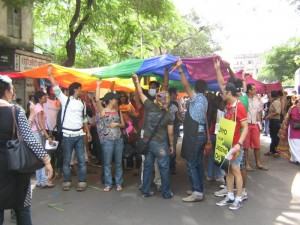
rainbow flag
I think the basic reason behind the discrimination against gays in India is the communication gap, especially about sex practices, between straights and gays and 150 years of section 377. Section 377 changed our society a lot; it changed the mind overtime. When I look at Hindu religious books and history I find that gay sex practices have always been part of Hindu culture. It was not any issue at all and we were the most liberal society on the planet but the British changed everything in India. Well, we are getting rid of the poverty given by them slowly and I hope to get rid of this crazy system also.
VIDEOS ARE COMING SOON
